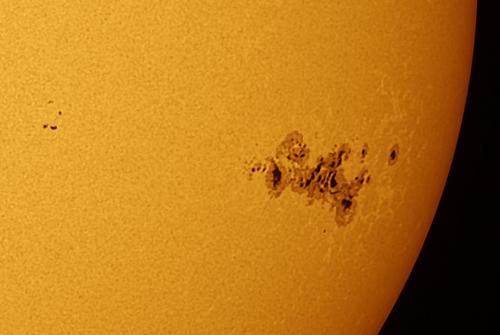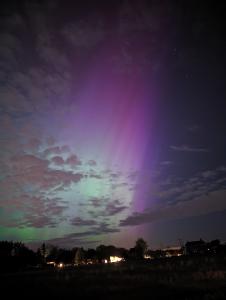Celebration of Space - May 31, 2024

Sunspot group AR 3664 on May 11, 2024. Image credit: Frosty Drew Astronomy Team member, Scott MacNeill
This past week, sunspot group AR 3664 – now re-designated as AR 3697, has returned to the side of the Sun visible from Earth. What makes this so notable is that AR 3664 is the sunspot group that triggered the amazing Aurora Borealis views of May 10-12, 2024. Some of which were visible over Mexico. It is impressive to note that the sunspot group has survived for one full period of the Sun’s axial rotation. But does this mean we will have another fabulous showing of the Northern Lights? Probably not, but maybe.
Depending on where you are on the Sun, the sidereal period of the Sun will vary. The sidereal period is the time it takes for the Sun to complete on full rotation on its axis. The polar regions of the Sun have a sidereal period of near 36 days, where the equatorial region has a sidereal period of 25 days. Sunspot group AR 3697 is located just below the equatorial region on the Sun’s southern hemisphere. At this location the sidereal period is about 26 days.
Most sunspot groups will break up before completing one full sidereal period, but there have been exceptions. AR 3664 was quite a large sunspot group. Large enough to be visible with just eclipse glasses. AR 3697 is not as large, but it is still quite active. On Wednesday, May 29th, this sunspot group created an X1.4 class flare, which is quite significant. The flare was not Earth facing, but it may graze our magnetic field sometime today. If so, we could see the Aurora Borealis visible over the more northern states like ME, NH, and VT, but not RI. Now that AR 3697 has rotated into an Earth-facing position, we will keep a close eye on the sunspot group for the next several days. All we need is another series of intense flares consecutively to have a repeat of the May 10-12th event. We make that sound easy, but it is highly unlikely to have another showing of the Aurora like that over Rhode Island, but we can always hope. Check out this image we captured of sunspot group AR 3664this image we captured of sunspot group AR 3664 on May 11, 2024.
This coming Thursday, June 6, 2024 at 8:40 am ET, the new Moon will occur. On that day, the Moon will rise and set with the Sun, leaving the entire nighttime period without the brightness of the Moon. No Moon means awesome views of the Milky Way with thousands of stars visible. A couple things to note. Even though the Moon is not present, clouds need to stay away as well, this also goes for haze and fog. Any artificial light will interfere with the view, even your smartphone’s backlight. Timings matter too, as the Milky Way is still prime for viewing in the early morning hours after midnight.
The night of the new Moon is not the only opportunity one would get to spot the Milky Way. In fact, you have nearly two weeks of opportunities to do so. These opportunities are kicking in around tonight, and will last until the waxing gibbous Moon gets into the morning sky. As of today, midnight – 3:00 am looks prime for viewing. As long as the Moon is not in the sky during those times, you can catch a view. This gives us until June 18th to catch sight of the Milky Way. If you happen to catch a pic of the Milky Way send it to us as a reply to this or by sending to astronomer@frostydrew.org.
If you find that you have insomnia tomorrow morning, Saturday, June 1st. Step outside around 4:00 am and attempt a view of the 31% waning crescent Moon sitting between Mars and Saturn over the ESE sky. It won’t be an amazing view, but Mars will be the east-most object, with the Moon about 15º westward, followed by Saturn at another 15º westward. Let us know if you see it.
- Author:
- Scott MacNeill
- Entry Date:
- May 31, 2024
- Published Under:
- Scott MacNeill's Columns



